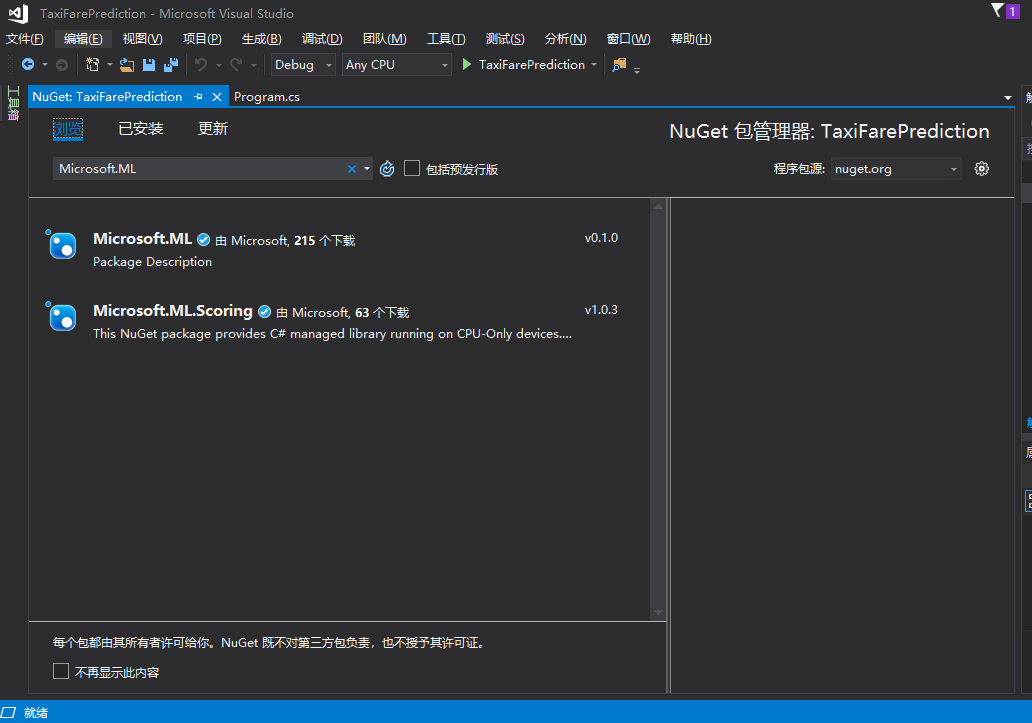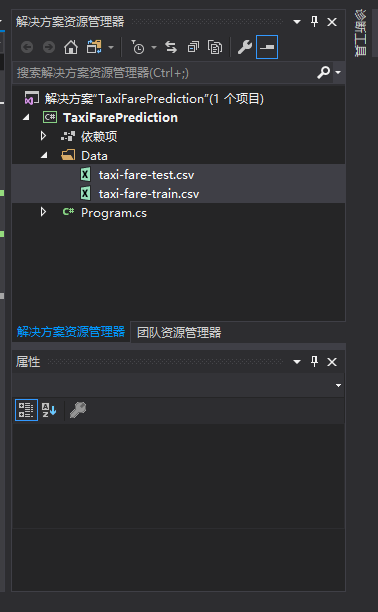使用ML.NET预测纽约出租车费
有了上一篇《.NET Core玩转机器学习》打基础,这一次我们以纽约出租车费的预测做为新的场景案例,来体验一下回归模型。
场景概述
我们的目标是预测纽约的出租车费,乍一看似乎仅仅取决于行程的距离和时长,然而纽约的出租车供应商对其他因素,如额外的乘客数、信用卡而不是现金支付等,会综合考虑而收取不同数额的费用。纽约市官方给出了一份样本数据。

确定策略
为了能够预测出租车费,我们选择通过机器学习建立一个回归模型。使用官方提供的真实数据进行拟合,在训练模型的过程中确定真正能影响出租车费的决定性特征。在获得模型后,对模型进行评估验证,如果偏差在接受的范围内,就以这个模型来对新的数据进行预测。
解决方案
创建项目
看过上一篇文章的读者,就比较轻车熟路了,推荐使用Visual Studio 2017创建一个.NET Core的控制台应用程序项目,命名为TaxiFarePrediction。使用NuGet包管理工具添加对Microsoft.ML的引用。


准备数据集
下载训练数据集taxi-fare-train.csv和验证数据集taxi-fare-test.csv,数据集的内容类似为:
vendor_id,rate_code,passenger_count,trip_time_in_secs,trip_distance,payment_type,fare_amount
VTS,1,1,1140,3.75,CRD,15.5
VTS,1,1,480,2.72,CRD,10.0
VTS,1,1,1680,7.8,CSH,26.5
VTS,1,1,600,4.73,CSH,14.5
VTS,1,1,600,2.18,CRD,9.5
...对字段简单说明一下:
字段名 含义 说明 vendor_id 供应商编号 特征值 rate_code 比率码 特征值 passenger_count 乘客人数 特征值 trip_time_in_secs 行程时长 特征值 trip_distance 行程距离 特征值 payment_type 支付类型 特征值 fare_amount 费用 目标值 在项目中添加一个Data目录,将两份数据集复制到该目录下,对文件属性设置“复制到输出目录”。


定义数据类型和路径
首先声明相关的包引用。
using System;
using Microsoft.ML.Models;
using Microsoft.ML.Runtime;
using Microsoft.ML.Runtime.Api;
using Microsoft.ML.Trainers;
using Microsoft.ML.Transforms;
using System.Collections.Generic;
using System.Linq;
using Microsoft.ML;在Main函数的上方定义一些使用到的常量。
const string DataPath = @".\Data\taxi-fare-train.csv";
const string TestDataPath = @".\Data\taxi-fare-test.csv";
const string ModelPath = @".\Models\Model.zip";
const string ModelDirectory = @".\Models";接下来定义一些使用到的数据类型,以及和数据集中每一行的位置对应关系。
public class TaxiTrip
{
[Column(ordinal: "")]
public string vendor_id;
[Column(ordinal: "")]
public string rate_code;
[Column(ordinal: "")]
public float passenger_count;
[Column(ordinal: "")]
public float trip_time_in_secs;
[Column(ordinal: "")]
public float trip_distance;
[Column(ordinal: "")]
public string payment_type;
[Column(ordinal: "")]
public float fare_amount;
} public class TaxiTripFarePrediction
{
[ColumnName("Score")]
public float fare_amount;
} static class TestTrips
{
internal static readonly TaxiTrip Trip1 = new TaxiTrip
{
vendor_id = "VTS",
rate_code = "",
passenger_count = ,
trip_distance = 10.33f,
payment_type = "CSH",
fare_amount = // predict it. actual = 29.5
};
}创建处理过程
创建一个Train方法,定义对数据集的处理过程,随后声明一个模型接收训练后的结果,在返回前把模型保存到指定的位置,以便以后直接取出来使用不需要再重新训练。
public static async Task<PredictionModel<TaxiTrip, TaxiTripFarePrediction>> Train()
{
var pipeline = new LearningPipeline(); pipeline.Add(new TextLoader<TaxiTrip>(DataPath, useHeader: true, separator: ","));
pipeline.Add(new ColumnCopier(("fare_amount", "Label")));
pipeline.Add(new CategoricalOneHotVectorizer("vendor_id",
"rate_code",
"payment_type"));
pipeline.Add(new ColumnConcatenator("Features",
"vendor_id",
"rate_code",
"passenger_count",
"trip_distance",
"payment_type"));
pipeline.Add(new FastTreeRegressor());
PredictionModel<TaxiTrip, TaxiTripFarePrediction> model = pipeline.Train<TaxiTrip, TaxiTripFarePrediction>();
if (!Directory.Exists(ModelDirectory))
{
Directory.CreateDirectory(ModelDirectory);
}
await model.WriteAsync(ModelPath);
return model;
}评估验证模型
创建一个Evaluate方法,对训练后的模型进行验证评估。
public static void Evaluate(PredictionModel<TaxiTrip, TaxiTripFarePrediction> model)
{
var testData = new TextLoader<TaxiTrip>(TestDataPath, useHeader: true, separator: ",");
var evaluator = new RegressionEvaluator();
RegressionMetrics metrics = evaluator.Evaluate(model, testData);
// Rms should be around 2.795276
Console.WriteLine("Rms=" + metrics.Rms);
Console.WriteLine("RSquared = " + metrics.RSquared);
}预测新数据
定义一个被用于预测的新数据,对于各个特征进行恰当地赋值。
static class TestTrips
{
internal static readonly TaxiTrip Trip1 = new TaxiTrip
{
vendor_id = "VTS",
rate_code = "",
passenger_count = ,
trip_distance = 10.33f,
payment_type = "CSH",
fare_amount = // predict it. actual = 29.5
};
}预测的方法很简单,prediction即预测的结果,从中打印出预测的费用和真实费用。
var prediction = model.Predict(TestTrips.Trip1); Console.WriteLine("Predicted fare: {0}, actual fare: 29.5", prediction.fare_amount);运行结果

到此我们完成了所有的步骤,关于这些代码的详细说明,可以参看《Tutorial: Use ML.NET to Predict New York Taxi Fares (Regression)》,只是要注意该文中的部分代码有误,由于使用到了C# 7.1的语法特性,本文的代码是经过了修正的。完整的代码如下:
using System;
using Microsoft.ML.Models;
using Microsoft.ML.Runtime;
using Microsoft.ML.Runtime.Api;
using Microsoft.ML.Trainers;
using Microsoft.ML.Transforms;
using System.Collections.Generic;
using System.Linq;
using Microsoft.ML;
using System.Threading.Tasks;
using System.IO; namespace TaxiFarePrediction
{
class Program
{
const string DataPath = @".\Data\taxi-fare-train.csv";
const string TestDataPath = @".\Data\taxi-fare-test.csv";
const string ModelPath = @".\Models\Model.zip";
const string ModelDirectory = @".\Models"; public class TaxiTrip
{
[Column(ordinal: "")]
public string vendor_id;
[Column(ordinal: "")]
public string rate_code;
[Column(ordinal: "")]
public float passenger_count;
[Column(ordinal: "")]
public float trip_time_in_secs;
[Column(ordinal: "")]
public float trip_distance;
[Column(ordinal: "")]
public string payment_type;
[Column(ordinal: "")]
public float fare_amount;
} public class TaxiTripFarePrediction
{
[ColumnName("Score")]
public float fare_amount;
} static class TestTrips
{
internal static readonly TaxiTrip Trip1 = new TaxiTrip
{
vendor_id = "VTS",
rate_code = "",
passenger_count = ,
trip_distance = 10.33f,
payment_type = "CSH",
fare_amount = // predict it. actual = 29.5
};
} public static async Task<PredictionModel<TaxiTrip, TaxiTripFarePrediction>> Train()
{
var pipeline = new LearningPipeline(); pipeline.Add(new TextLoader<TaxiTrip>(DataPath, useHeader: true, separator: ","));
pipeline.Add(new ColumnCopier(("fare_amount", "Label")));
pipeline.Add(new CategoricalOneHotVectorizer("vendor_id",
"rate_code",
"payment_type"));
pipeline.Add(new ColumnConcatenator("Features",
"vendor_id",
"rate_code",
"passenger_count",
"trip_distance",
"payment_type"));
pipeline.Add(new FastTreeRegressor());
PredictionModel<TaxiTrip, TaxiTripFarePrediction> model = pipeline.Train<TaxiTrip, TaxiTripFarePrediction>();
if (!Directory.Exists(ModelDirectory))
{
Directory.CreateDirectory(ModelDirectory);
}
await model.WriteAsync(ModelPath);
return model;
} public static void Evaluate(PredictionModel<TaxiTrip, TaxiTripFarePrediction> model)
{
var testData = new TextLoader<TaxiTrip>(TestDataPath, useHeader: true, separator: ",");
var evaluator = new RegressionEvaluator();
RegressionMetrics metrics = evaluator.Evaluate(model, testData);
// Rms should be around 2.795276
Console.WriteLine("Rms=" + metrics.Rms);
Console.WriteLine("RSquared = " + metrics.RSquared);
} static async Task Main(string[] args)
{
PredictionModel<TaxiTrip, TaxiTripFarePrediction> model = await Train();
Evaluate(model); var prediction = model.Predict(TestTrips.Trip1); Console.WriteLine("Predicted fare: {0}, actual fare: 29.5", prediction.fare_amount);
}
}
}
不知不觉我们的ML.NET之旅又向前进了一步,是不是对于使用.NET Core进行机器学习解决现实生活中的问题更有兴趣了?请保持关注吧。
使用ML.NET预测纽约出租车费的更多相关文章
- ML.NET教程之出租车车费预测(回归问题)
理解问题 出租车的车费不仅与距离有关,还涉及乘客数量,是否使用信用卡等因素(这是的出租车是指纽约市的).所以并不是一个简单的一元方程问题. 准备数据 建立一控制台应用程序工程,新建Data文件夹,在其 ...
- [codeup] 1128 出租车费
题目描述 某市出租车计价规则如下:起步4公里10元,即使你的行程没超过4公里:接下来的4公里,每公里2元:之后每公里2.4元.行程的最后一段即使不到1公里,也当作1公里计费. 一个乘客可以根据行程公里 ...
- [ACM_数学] Taxi Fare [新旧出租车费差 水 分段函数]
Description Last September, Hangzhou raised the taxi fares. The original flag-down fare in Hangzhou ...
- 使用ML.NET实现猜动画片台词
前面几篇主要内容出自微软官方,经我特意修改的案例的文章: 使用ML.NET实现情感分析[新手篇] 使用ML.NET预测纽约出租车费 .NET Core玩转机器学习 使用ML.NET实现情感分析[新手篇 ...
- 使用ML.NET实现情感分析[新手篇]
在发出<.NET Core玩转机器学习>和<使用ML.NET预测纽约出租车费>两文后,相信读者朋友们即使在不明就里的情况下,也能按照内容顺利跑完代码运行出结果,对使用.NET ...
- ML.NET
ML.NET http://www.cnblogs.com/BeanHsiang/category/1218714.html 随笔分类 - 使用ML.NET实现NBA得分预测 摘要: 本文将介绍一种特 ...
- ML.NET 示例:回归之价格预测
写在前面 准备近期将微软的machinelearning-samples翻译成中文,水平有限,如有错漏,请大家多多指正. 如果有朋友对此感兴趣,可以加入我:https://github.com/fei ...
- C#使用ML.Net完成人工智能预测
前言 Visual Studio2019 Preview中提供了图形界面的ML.Net,所以,只要我们安装Visual Studio2019 Preview就能简单的使用ML.Net了,因为我的电脑已 ...
- GIS+=地理信息+行业+大数据——纽约公开11亿条出租车和Uber原始数据下载及分析
一览众山小编辑团队 原文/ Todd Schneider 翻译/ 沈玮薇 陈翚 文献/ 蒋理 校核/ 众山小编辑/ 众山小 排版/ 徐颖 2014-2015 © 转载请注明:源自公众号"一览 ...
随机推荐
- 2018-2019-2 20165319 《网络对抗技术》 Exp5:MSF基础应用
实验内容 metasploit中有六个模块分别是 渗透攻击模块(Exploit Modules) 辅助模块(Auxiliary Modules 攻击载荷(Payload Modules) 空字段模块( ...
- Java类是如何默认继承Object的
前言 学过Java的人都知道,Object是所有类的父类.但是你有没有这样的疑问,我并没有写extends Object,它是怎么默认继承Object的呢? 那么今天我们就来看看像Java这种依赖于虚 ...
- MySQL数据库的定时备份
1. 创建shell脚本 vim backupdb.sh 创建脚本内容如下: #!/bin/sh db_user="root" db_passwd=" db_name=& ...
- 吻逗死(windows)系统下自动部署脚本(for java spring*)及linux命令行工具
转载请注明出处:https://www.cnblogs.com/funnyzpc/p/10051647.html (^^)(^^)自動部署腳本原本在上個公司就在使用,由於近期同事需要手動部署一個Spr ...
- sql server 关于日期格式转换查询备注
select GETDATE()--2016-01-08 16:15:05.787select convert(varchar,getdate(),11)--16/01/08select conver ...
- 从零开始构建一个centos+jdk7+tomcat7的docker镜像文件
从零开始构建一个centos+jdk7+tomcat7的镜像文件 centos7系统下docker运行环境的搭建 准备centos基础镜像 docker pull centos 或者直接下载我准备好的 ...
- 解决挂载nfs共享目录失败的问题
现象:在192.168.82.131上 启动了nfs服务,并共享了/nfsfile目录,在另一台主机(ip: 192.1168.82.115)挂载的时候一直阻塞 1 初步分析是防火墙拦截导致,于是进行 ...
- 五、JAVA反射、线程
第五节:Java反射.线程 线程 1.进程:进程是程序的基本执行实体,进程是线程的容器. 线程:被称为轻量进程,是程序执行流的最小单元.线程是进程中的一个实 ...
- vue的登陆验证及返回登录前页面实现
一.路由配置部分如下所示, 导出路由示例 let router = new VueRouter({ routes: [ // 登陆 { name: 'login', path: '/login', c ...
- python从入门到实践-10章文件和异常(括号问题)
#!/user/bin/env python# -*- coding:utf-8 -*- # 1.从文件中读取数据with open('pi_digits.txt') as file_object: ...
